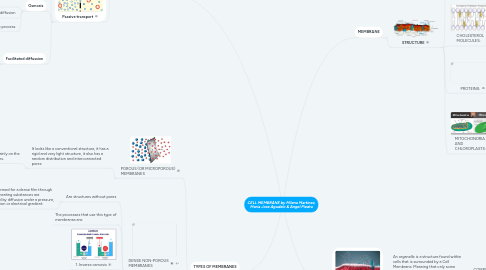
1. CELL TRANSPORT
1.1. ACTIVE TRANSPORT
1.1.1. Active Transport moves molecules from a low concentration to a high concentration
1.1.2. Requires energy for membrane proteins to move molecules against the concentration gradient in order to maintain the gradient
1.2. Passive transport
1.2.1. Difussion
1.2.1.1. Diffusion is the movement of molecules from a region of high concentration to a region of low concentration until they are evenly spread out
1.2.1.2. Occurs down a concentration gradient
1.2.1.3. Diffusion is a passive process
1.2.1.3.1. Meaning that NO ENERGY IS NEEDED by the cell
1.2.1.4. Diffusion is the main process involved when molecules pass through cell membranes
1.2.2. Osmosis
1.2.2.1. Osmosis is the movement of water molecules from high concentration to a low concentration, along a concentration gradient and through a selectively permeable membrane
1.2.2.2. Osmosis is a form of diffusion
1.2.2.3. Osmosis is a passive process
1.2.2.3.1. Meaning that NO ENERGY IS NEEDED by the cell
1.2.3. Facilitated diffussion
1.2.3.1. Sometimes molecules can't get through the membrane without a little help
1.2.3.2. A special protein embeded in the membrane helps moleculas move across
1.2.3.3. NO ENERGY IS REQURED, this is still passive transport
2. TYPES OF MEMBRANES
2.1. POROUS (OR MICROPOROUS) MEMBRANES
2.1.1. It looks like a conventional structure, it has a rigid and very light structure, it also has a random distribution and interconnected pores
2.1.1.1. The separation depends mainly on the molecular size and the pores.
2.1.1.1.1. The processes that use this type of membranes are:
2.1.1.1.2. 1. Microfiltration 2. Ultrafiltration
2.2. DENSE NON-POROUS MEMBRANES
2.2.1. Are structures without pores
2.2.1.1. They are formed for a dense film through which permeating substances are transported by diffusion under a pressure, concentration or electrical gradient.
2.2.1.1.1. The separation of the various components of a mixture depends on their relative transport speed
2.2.2. The processes that use this type of membranes are:
2.2.3. 1. Inverse osmosis
2.2.4. 2. Nanofiltration
2.3. SYMMETRIC (OR ISOTROPIC) MEMBRANES
2.3.1. Show a uniform composition and physical structure in cross-section
2.3.1.1. It is characterized by presenting the same resistance to flow throughout the membrane.
2.3.1.1.1. This type of membrane can be porous, dense and electrically charged.
2.4. Asymmetric (or anisotropic) membranes
2.4.1. This membranes are composed for structures laminar or tubulars where the size pores, porosity or the membrane composition change along of its thickness
2.4.1.1. It has a thin layer supported in other more gross and porous
2.4.1.2. 1. the first layer is responsible for the separation process and the second layer provides the system with sufficient mechanical strength to withstand the working conditions
3. MEMBRANE
3.1. STRUCTURE
3.1.1. With few exceptions, cellular membranes including plasma membranes and internal membranes are made of glycerophospholipids.
3.1.1.1. GLYCEROL:
3.1.1.1.1. Glycerol is a three-carbon molecule that functions as the backbone of these membrane lipids.
3.1.1.2. GLYCEROPHOSPHOLIPIDS:
3.1.1.2.1. Glycerophospholipids molecules composed of glycerol, a phosphate group, and two fatty acid chains. fatty acids are attached to the first and second carbons, and the phosphate group is attached to the third carbon of the glycerol backbone.
3.1.2. CHOLESTEROL MOLECULES:
3.1.2.1. Although less abundant than glycerophospholipids, account for about 20 percent of the lipids in animal cell plasma membranes.
3.1.2.2. helps regulate the stiffness of membranes, while other less prominent lipids play roles in cell signaling and cell recognition.
3.1.3. PROTEINS:
3.1.3.1. Proteins account for roughly half the mass of most cellular membranes.
3.1.3.1.1. Therefore, the collection of lipids and proteins that make up a cellular membrane relies on natural biophysical properties to form and function.
3.1.3.2. Many of these proteins are embedded into the membrane and stick out on both sides; these are called transmembrane proteins.
3.1.4. MITOCHONDRIA AND CHLOROPLASTS:
3.1.4.1. Are also surrounded by membranes, but they have unusual membrane structures specifically, each of these organelles has two surrounding membranes instead of just one.
3.1.4.1.1. The outer membrane of mitochondria and chloroplasts has pores that allow small molecules to pass easily.
3.1.4.1.2. The double membrane enclosures of mitochondria and chloroplasts are similar to certain modern-day prokaryotes and are thought to reflect these organelles' evolutionary origins.
4. WHAT IS?
4.1. An organelle is a structure found within cells that is surrounded by a Cell Membrane. Meaning that only some substances can pass through. Is fluid and constantly moving, semi-permeable.
4.1.1. COMPOUND:
4.1.1.1. PROTEINS:
4.1.1.1.1. They act as carriers which 'actively' pump molecules across the membrane. They act as receptors for hormones arriving at the cell
4.1.1.1.2. They form pores in the Cell Membrane allowing small molecules to pass through. They serve as enzymes.
4.1.1.2. PHOSPHOLIPIDS:
4.1.1.2.1. The Phospholipid's head is hydrophilic which means it is attracted to water.
4.1.1.2.2. The Phospholipid's the tail is hydrophobic which means it hates water.
